Many of us spend hours each day using a computer mouse, making pointer finger pain a surprisingly common ailment. This pain can range from a mild ache to a debilitating throbbing, significantly impacting productivity and quality of life. Understanding the causes, implementing preventative measures, and seeking appropriate treatment are crucial for managing and overcoming this issue.
What Causes Pointer Finger Pain from Using a Mouse?
Pointer finger pain stemming from mouse use often arises from repetitive strain injuries (RSIs). These injuries develop over time due to repeated movements and awkward postures. Several factors contribute:
-
Repetitive Strain Injuries (RSIs): Continuously clicking, scrolling, and moving the mouse puts stress on the tendons, muscles, and nerves in your hand and forearm. This repetitive strain can lead to conditions like tendonitis, carpal tunnel syndrome, and De Quervain's tenosynovitis.
-
Poor Posture: Slouching, hunching over your keyboard, and resting your wrist improperly can exacerbate the strain on your hand and wrist, increasing the likelihood of pointer finger pain.
-
Incorrect Mouse Grip: Holding the mouse too tightly or using an awkward grip puts undue pressure on your hand and fingers, leading to pain and discomfort.
-
Ergonomic Issues: Using an unsuitable mouse, keyboard, or chair can significantly contribute to the problem. A poorly designed workspace forces your body into unnatural positions, increasing strain.
-
Underlying Medical Conditions: Pre-existing conditions like arthritis or nerve damage can make you more susceptible to pointer finger pain from mouse use.
What are the Symptoms of Pointer Finger Pain from Mouse Use?
The symptoms can vary in severity, but common indicators include:
- Aching or throbbing pain: This pain might be localized to the pointer finger or radiate up the arm.
- Stiffness and limited range of motion: You might find it difficult to fully bend or straighten your finger.
- Numbness or tingling: This sensation can occur in the pointer finger, thumb, or other fingers.
- Weakness in the hand: You may experience a decrease in grip strength or difficulty performing fine motor tasks.
- Inflammation: The affected area may appear swollen or red.
How Can I Prevent Pointer Finger Pain from Using a Mouse?
Prevention is key when it comes to RSI. Implementing these strategies can significantly reduce your risk:
-
Maintain Good Posture: Sit upright with your feet flat on the floor, your elbows at a 90-degree angle, and your wrists straight.
-
Use an Ergonomic Mouse: Consider a vertically oriented mouse or one designed to support a natural hand position.
-
Take Regular Breaks: Get up and move around every 30-60 minutes. Perform simple hand and wrist stretches to relieve tension.
-
Use Proper Mouse Technique: Avoid gripping the mouse too tightly. Use your whole hand, not just your fingers, to control the mouse.
-
Adjust Your Workspace: Ensure your keyboard and mouse are positioned within easy reach to avoid reaching or stretching. Use a supportive chair with adjustable height and lumbar support.
What Treatments are Available for Pointer Finger Pain Caused by Mouse Use?
If you're experiencing pointer finger pain, several treatment options can provide relief:
-
Rest and Ice: Avoid using the mouse as much as possible and apply ice packs to reduce inflammation.
-
Over-the-Counter Pain Relievers: Ibuprofen or naproxen can help manage pain and inflammation.
-
Physical Therapy: A physical therapist can teach you specific exercises and stretches to improve hand and wrist strength and flexibility. They can also provide ergonomic assessments and recommendations.
-
Splints or Braces: These can help immobilize your wrist and reduce strain on your tendons.
-
Medical Interventions: In severe cases, your doctor might recommend injections of corticosteroids or surgery.
What are some Exercises to Relieve Pointer Finger Pain?
Simple exercises can significantly help alleviate pain and improve hand function. These should be done gently and stopped if pain increases. Consult a physical therapist for a personalized exercise plan. Examples include:
- Wrist Extensions and Flexions: Gently bend your wrist up and down.
- Finger Stretches: Extend and flex your fingers individually, holding each stretch for a few seconds.
- Thumb Stretches: Gently stretch your thumb across your palm and towards your little finger.
How Can I Choose the Right Ergonomic Mouse?
Choosing the right ergonomic mouse involves considering several factors:
- Vertical Design: These mice encourage a more natural hand position, reducing wrist strain.
- Size and Shape: Select a mouse that fits comfortably in your hand.
- Buttons and Functionality: Consider additional buttons for customization and ease of use.
Does Carpal Tunnel Syndrome Cause Pointer Finger Pain?
Yes, carpal tunnel syndrome is a common cause of pointer finger pain, along with numbness and tingling in the thumb, index, middle, and sometimes ring finger. The carpal tunnel is a narrow passageway in your wrist, and inflammation or compression of the median nerve within this passageway can lead to these symptoms.
Addressing pointer finger pain from mouse use requires a multi-pronged approach. By understanding the causes, implementing preventative measures, and seeking appropriate treatment, you can alleviate pain and return to using your computer comfortably. Remember to consult with a healthcare professional for diagnosis and personalized treatment recommendations.
